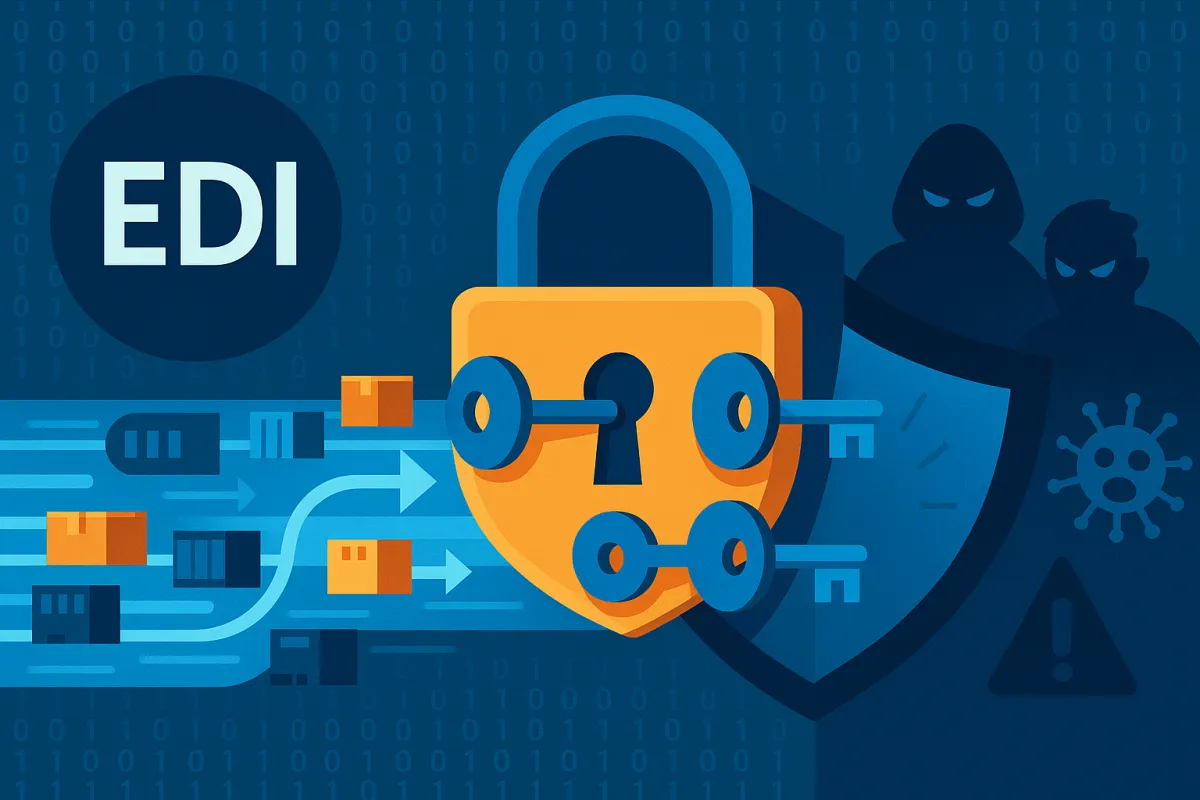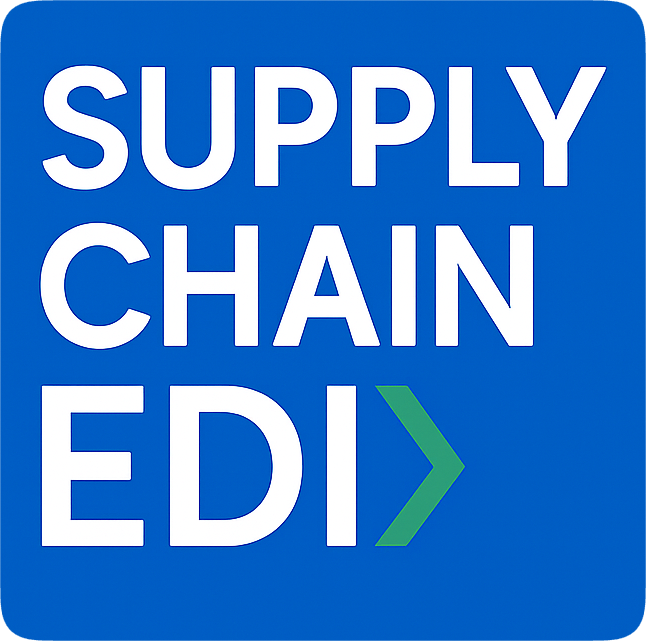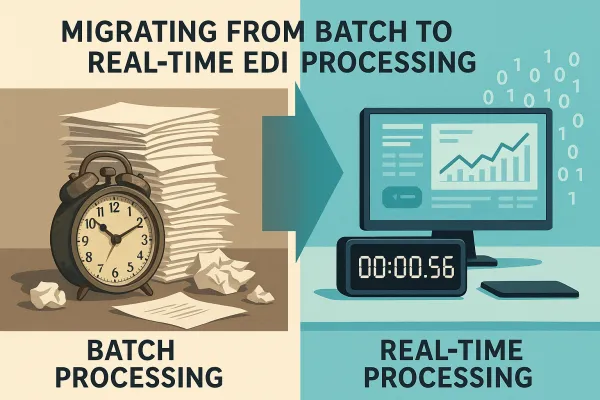The Complete EDI Multi-Factor Authentication Implementation Guide: Securing Supply Chain Data Exchange Against Zero-Day Threats in 2025

Multi-factor authentication represents the most cost-effective defense against nearly 30% of Known Exploited Vulnerabilities (KEVs) that were weaponized within 24 hours of disclosure in 2025. With more than 23,600 vulnerabilities published in the first half of 2025 alone, representing a 16% increase over 2024, EDI systems face unprecedented exposure windows that traditional security measures can't address.
This comprehensive guide provides the step-by-step framework for implementing robust EDI multi-factor authentication across your supply chain data exchange environment, addressing the specific challenges that differentiate EDI security from standard enterprise authentication deployments.
The Critical MFA Gap in EDI Security
The current threat landscape has fundamentally shifted how attackers approach EDI systems. According to the 2025 Verizon Data Breach Investigations Report (DBIR), exploitation of vulnerabilities now accounts for 20% of all breaches, up 34% year-over-year, with edge and VPN device flaws representing the fastest-growing attack vector.
Human error remains a significant contributor to data breaches, but automated exploitation poses an even greater risk to EDI environments. These cases show that ransomware groups increasingly prefer exploit-based access. It is faster, more scalable, and harder to detect than social engineering. Traditional EDI security measures - static passwords, certificates, and VPN access - create single points of failure that sophisticated attackers can bypass within hours of vulnerability disclosure.
EDI systems present unique vulnerabilities because they often run 24/7 with minimal human oversight, rely on legacy authentication protocols, and handle high-value supply chain data. When cybercriminals can exploit vulnerabilities to gain unauthorized access to sensitive information exchanged through EDI, leading to data leaks and financial loss, the business impact extends far beyond your organization to affect entire trading partner networks.
The financial stakes are substantial. Account takeovers have accounted for 81 percent of data breaches in recent years, and EDI-specific breaches often involve multiple trading partners, amplifying regulatory exposure and compliance penalties. Supply chain data breaches average $4.88 million in total costs, according to recent IBM research.
Understanding MFA Requirements for EDI Environments
Multi-factor authentication requires combining two or more of the following authentication methods: Something you know, typically a password, something you have (like a mobile device or hardware token), or something you are (biometric characteristics). However, EDI environments complicate this standard framework in several ways.
Automated EDI processes don't involve human users during routine operations, creating challenges for traditional MFA implementations that assume human interaction. Service accounts, API keys, and automated file transfers require different authentication approaches than user-based systems. Additionally, trading partner requirements often dictate specific authentication protocols that may not support modern MFA methods.
Compliance with data protection regulations such as GDPR (General Data Protection Regulation) and HIPAA (Health Insurance Portability and Accountability Act) is critical for businesses utilizing EDI. GDPR mandates appropriate measures to protect personal data, while HIPAA requires healthcare organizations to ensure confidentiality of protected health information exchanged through EDI. SOC 2 Type II compliance increasingly requires MFA for systems processing customer data.
Leading EDI providers have adapted their platforms differently. Platform Capabilities And Security Provides robust features and measures to protect data, control access, and ensure secure electronic data exchange, safeguarding sensitive information and maintaining system integrity across solutions like IBM Sterling and SPS Commerce. Modern TMS platforms including Cargoson, MercuryGate, Descartes, and Transporeon have built cloud-native authentication from the ground up, while legacy systems often require additional integration layers.
IBM Sterling B2B Integration Services offers the best security according to peer reviews, with comprehensive authentication options for both human and automated processes. SPS Commerce focuses on managed services that handle MFA implementation as part of their service offering, while Cleo emphasizes API-first authentication that supports modern MFA protocols.
MFA Implementation Architecture for EDI Systems
Successful EDI MFA implementations require a layered architecture that addresses both human-initiated and automated processes. Your implementation should separate authentication flows based on the type of EDI interaction: real-time API calls, scheduled file transfers, manual document uploads, and administrative access.
For API-based EDI integrations, implement OAuth 2.0 flows with client credentials for service-to-service authentication, combined with JWT tokens that include MFA claims. This approach allows your ERP systems to authenticate automatically while maintaining MFA requirements for human administrators who manage these integrations.
Traditional EDI protocols like AS2 and SFTP require different approaches. AS2 supports digital certificates combined with MFA for initial connection establishment, while SFTP can leverage SSH key-based authentication with MFA requirements for key management systems. The platform supports a broad array of communication protocols, including AS2, FTP, SFTP, and HTTP/S, enabling organizations to connect with different partners and systems effortlessly.
Database and ERP integration security layers represent the most critical component. Your MFA system must authenticate not just the initial EDI connection, but also the downstream systems that process EDI data. This often requires federation between your EDI platform's authentication system and your enterprise identity management solution.
Cloud vs. On-Premise MFA Deployment
Cloud-based MFA solutions eliminate upfront infrastructure costs and offer pay-as-you-go models that scale with your trading partner network growth. However, EDI systems often run in hybrid environments where some partners require on-premise connectivity for security or compliance reasons.
Pure cloud approaches work best for companies with modern EDI platforms and flexible trading partner requirements. Solutions like Microsoft Entra ID, Okta, and AWS IAM provide robust APIs for integration with cloud-native EDI platforms. Research by Microsoft shows that MFA can block more than 99.2% of account compromise attacks, making cloud MFA particularly effective for EDI security.
Hybrid approaches accommodate legacy systems while providing modern authentication capabilities. This typically involves deploying MFA proxies or gateways that can authenticate users and systems before forwarding requests to on-premise EDI infrastructure. Companies like Cargoson offer cloud-native platforms that support hybrid authentication, while MercuryGate, Descartes, and Transporeon provide various deployment models to accommodate different security requirements.
On-premise deployments remain necessary for highly regulated industries or companies with specific data sovereignty requirements. These implementations require dedicated hardware for MFA servers, backup systems, and integration with existing directory services.
Step-by-Step EDI MFA Implementation Process
Begin by defining clear objectives based on your specific EDI usage patterns. Inventory all EDI touchpoints including automated processes, manual uploads, administrative access, and partner-facing portals. Document which systems require MFA based on data sensitivity, compliance requirements, and business risk tolerance.
Your pre-implementation security audit should catalog existing authentication mechanisms, identify single points of failure, and assess integration complexity with current EDI platforms. Pay particular attention to service accounts and automated processes that may need special handling during MFA rollout.
Partner notification represents a critical step that many implementations overlook. EDI trading relationships involve contractual SLAs and technical specifications that may need updates to accommodate MFA requirements. Provide partners with at least 90 days notice and technical documentation showing how MFA will affect their integration patterns.
Implement a phased rollout strategy starting with internal users and low-volume trading partners. This allows you to identify integration issues and performance impacts before affecting critical business processes. Begin with human users accessing EDI administrative interfaces, then add automated systems, and finally extend to all trading partner connections.
Testing procedures must validate both successful authentication and failure scenarios. Verify that MFA doesn't introduce latency that violates SLA requirements, ensure that authentication failures don't cause data loss, and confirm that backup authentication methods work correctly. Document all test results for compliance audits.
Configuring MFA Methods for Different EDI Scenarios
Push notifications through authenticator apps provide the best user experience for human-initiated EDI processes. For the best flexibility and usability, use the Microsoft Authenticator app. This authentication method provides the best user experience and multiple modes, such as passwordless, MFA push notifications, and OATH codes. The Microsoft Authenticator app also meets the National Institute of Standards and Technology (NIST) Authenticator Assurance Level 2 requirements.
However, cybersecurity professionals have long advocated that two-factor authentication utilizing text messages (SMS) is less secure than other methods. The US government stopped using SMS authentication in 2016 — and encouraged others to do the same. For EDI systems, SMS-based authentication creates additional risks because mobile networks can be compromised, and SMS delivery isn't guaranteed for time-sensitive EDI processes.
For automated EDI transactions, implement service account authentication using certificate-based MFA combined with IP address restrictions. Generate unique client certificates for each automated process, store private keys in hardware security modules or secure key management systems, and require MFA for certificate renewal processes. This approach maintains automation while adding security layers.
Hardware tokens work well for high-security EDI environments, particularly in regulated industries. Security keys: These are physical devices, like a YubiKey, used as a second factor for authentication. Security keys have no battery requirements, are phishing resistant, and support multiple users on a single device. For EDI administrators who manage multiple trading partner connections, hardware tokens provide consistent authentication without relying on mobile devices.
Partner-specific authentication requirements often dictate available options. Some trading partners may require specific certificate authorities, particular authentication protocols, or custom integration methods. Document these requirements during your planning phase and ensure your MFA solution can accommodate partner-specific variations.
Common Implementation Pitfalls and Solutions
Insider threats remain a significant concern even with MFA implementation. Human error remains a significant contributor to data breaches. Educating employees about the importance of data security, raising awareness about common phishing techniques, and providing regular training on best practices can go a long way in preventing security incidents. Implement role-based access controls that limit MFA bypass capabilities and ensure that privileged accounts require additional authentication steps.
Legacy system integration challenges often derail MFA implementations. Older EDI systems may not support modern authentication protocols, requiring middleware or gateway solutions to bridge the gap. Budget for these integration costs and plan additional testing time for legacy system compatibility.
Trading partner resistance can significantly delay implementation timelines. Some partners may refuse to upgrade their systems or may require extensive technical support to implement MFA on their end. Develop a partner communication strategy that includes business justification, technical documentation, and migration support to minimize resistance.
Performance impact on EDI transaction speeds requires careful monitoring and optimization. MFA adds authentication overhead that can affect time-sensitive processes like just-in-time inventory management or real-time shipping updates. Implement caching mechanisms for authenticated sessions and optimize authentication flows for high-volume trading partners.
Sophisticated phishing attacks can bypass some MFA methods through social engineering or real-time proxy attacks. Enabling MFA on all accounts that offer it is essential for reducing the cybersecurity risks to your business. However, some forms of MFA are more secure than others– as some forms of MFA can be susceptible to phishing threats such as One Time Pins (OTPs) and SMS ba. Implement adaptive authentication that considers context like location, device characteristics, and behavioral patterns to detect suspicious authentication attempts.
Monitoring and Maintenance Framework
Continuous monitoring capabilities must track both successful and failed authentication attempts across all EDI touchpoints. Monitoring user access logs, network traffic, and system logs can provide valuable insights into potential security incidents. Regularly reviewing and analyzing these logs can help identify vulnerabilities and ensure timely response and mitigation.
Establish security KPIs that measure MFA effectiveness: authentication failure rates, time-to-authenticate metrics, partner compliance levels, and incident response times. Set baseline measurements during initial implementation and track improvements over time. Monthly reporting should include trend analysis and recommendations for optimization.
Regular audits should verify that MFA implementations remain effective as your EDI environment evolves. Conduct frequent security audits and vulnerability assessments to identify and address potential weaknesses in the EDI system. This proactive approach helps organizations stay ahead of emerging threats. Quarterly reviews should assess new trading partner onboarding, system upgrades, and compliance requirement changes.
User feedback collection helps identify usability issues that could lead to security workarounds. Implement feedback channels that allow EDI users and trading partners to report authentication problems, suggest improvements, and highlight integration challenges. Address recurring issues promptly to maintain security compliance.
Incident response procedures for MFA-protected EDI systems require special considerations for business continuity. Develop runbooks that address MFA system failures, compromised credentials, and emergency access procedures. Test these procedures regularly and ensure that backup authentication methods don't compromise security.
Integration with modern monitoring solutions enhances visibility across your entire EDI ecosystem. Solutions from Blue Yonder and Manhattan Active provide comprehensive supply chain monitoring, while platforms like Cargoson offer built-in security dashboards that track authentication metrics alongside operational KPIs. This integrated approach helps identify correlation between authentication issues and business process disruptions.
Your next step should focus on conducting a comprehensive EDI security assessment that identifies specific MFA requirements for your environment. Start with cataloging all EDI access points, documenting trading partner authentication requirements, and evaluating your current authentication infrastructure's capabilities. This foundation will guide your implementation timeline and budget requirements while ensuring that your MFA deployment strengthens rather than disrupts critical supply chain operations.





